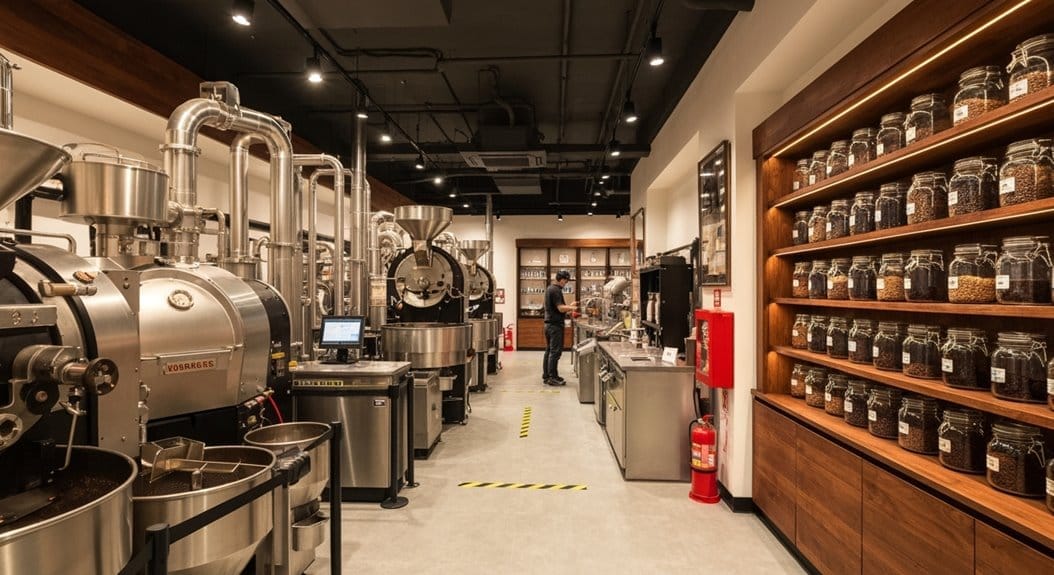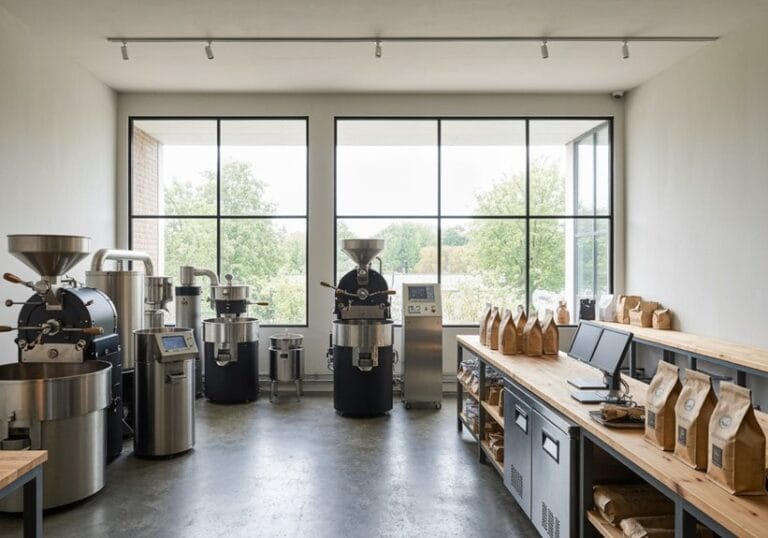Creating an efficient coffee roastery layout boils down to three key steps: initially, you’ve got to optimize that workflow—think about every little step from bean to brew! Next, place your equipment smartly, keeping things close so you’re not doing a coffee Olympics just to grab a tool. Finally, safety and compliance, folks! Nobody wants to play dodgeball with hot coffee! Stick around, and you’ll uncover more beans of wisdom on turning that layout into pure gold!
Key Takeaways
- Map the entire workflow from green bean intake to roasting to identify each step and streamline processes for efficiency.
- Place equipment strategically to reduce transport time and enhance operator comfort, promoting a seamless workflow.
- Design ergonomic workstations that minimize fatigue and support a smooth process with easy access to necessary tools.
- Implement safety measures like ventilation and personal protective equipment to prioritize worker health during the roasting process.
- Ensure compliance with regulatory guidelines while designing layouts that facilitate scalability for future growth and efficiency.
Understand Workflow and Space Utilization
Understanding workflow and space utilization in a coffee roastery can feel like trying to solve a Rubik’s cube blindfolded—frustrating, puzzling, and ultimately rewarding if you get it right!
It’s all about workflow mapping, folks! Envision defining every step from green bean intake to roasting—like creating a treasure map, but without pirates! Standardizing processes is the magic glue that keeps everything from flying apart! Optimizing ROI is a key factor in ensuring that the efficiency of your workflow translates into profitability.
Visualize this: clear steps make for fewer errors, which is great because we don’t want coffee disasters on our hands! Plus, integrating inventory data? That’s the cherry on top! It syncs stock and workflow, slicing through bottlenecks like a hot knife through butter.
Just keep an eye on labor—nobody wants a roaster doing the cha-cha between machines!
Equipment Placement and Ergonomics
Often, coffee roasteries feel like a bustling circus, where all the equipment is performing its own act—if only they could remember their lines! To avoid a chaotic scene, proper equipment placement is essential.
Imagine a roaster that’s too far from green bean storage—talk about a workout! Keeping that setup close minimizes transport time, and hey, who doesn’t want a bit of extra energy for their coffee fix, right?
Now, let’s not forget ergonomic tools! These beauties help keep operators comfy, reducing fatigue and those pesky strains.
Workstations should allow easy access, with tools stored nearby—no need for an Olympic sprint to grab a wrench! A well-planned layout keeps everyone moving smoothly, like a perfectly brewed cup of joe!
Safety, Scalability, and Regulatory Compliance

While it might seem like a coffee roastery runs on caffeine and chaos, safety, scalability, and compliance are the unsung heroes that keep the whole operation running smoothly.
Imagine this: roasting beans releases all kinds of nasty stuff—think respiratory hazards like “popcorn lung”—yikes! That’s where safety measures like proper ventilation and personal protective equipment come into play. You wouldn’t want to roast and toast without it, right?
Roasting beans can unleash harmful fumes—ventilation and protective gear are essential for a safe operation!
And hey, those regulatory guidelines? They’re not just for fun! Compliance with the FDA and Good Manufacturing Practices keeps everything from bean to cup safe.
As roasteries grow, they need layouts that adapt, ensuring quality and safety still go hand in hand.
Frequently Asked Questions
What Are the Best Materials for Coffee Roastery Flooring?
The best materials for coffee roastery flooring include concrete options for durability, finishes that guarantee easy cleaning, slip resistance, and sound absorption. Aesthetic appeal can be improved through diverse design choices that complement the environment.
How Can I Optimize Lighting in a Coffee Roastery?
To optimize lighting in a coffee roastery, balancing ambient brightness with task lighting is essential. This combination guarantees consistent visual assessment of bean colors while minimizing shadows, thereby enhancing the comprehensive roasting evaluation process and workflow efficiency.
What Storage Solutions Work Best for Green Coffee Beans?
Ideal green bean storage includes airtight containers that minimize oxygen and moisture exposure, enhancing freshness. Prioritizing airflow considerations by elevating storage solutions off the ground prevents moisture accumulation, ensuring quality preservation of green coffee beans.
How Frequently Should Equipment Maintenance Be Conducted?
Equipment maintenance should be conducted weekly for inspections and preventive maintenance, including cleaning airflow systems and mechanical components. Regular checks guarantee ideal performance, safety compliance, and timely identification of potential issues before they escalate.
What Are Common Mistakes in Roastery Layout Design?
Common mistakes in roastery layout design include inefficient circulation, inadequate equipment placement, and neglecting operator ergonomics. These factors lead to bottlenecks, reduced productivity, and increased labor costs, hindering overall operational effectiveness.
References
- https://berto-online.com/mastering-efficiency-optimizing-your-roastery-layout/
- https://artisticoffee.com/blogs/grow-your-cafe/cafe-layout-floorplan-advice
- https://perfectdailygrind.com/2019/04/how-to-design-your-coffee-roastery-for-maximum-efficiency/
- https://genioroasters.com/community/docs/installation-and-setup/positioning-and-roastery-layout
- https://coffeecrafters.com/coffee-talk/streamline-roasting-operations-for-optimal-smart-roi/
- https://finmodelslab.com/blogs/kpi-metrics/coffee-roastery-and-tasting-room
- https://www.roastertools.com/blog/better-production-flow-leads-to-better-cash-flow-for-coffee-roasters





